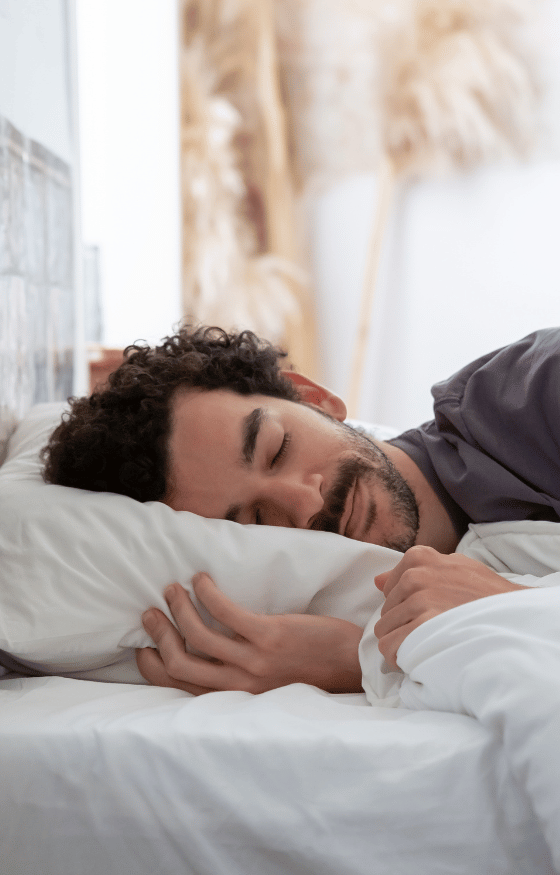Get 20% off 2 or more full priced Baxters or Wellbeing products! Add another full priced item below and a 20% discount will be applied to your overall order at checkout. That's right, 20% OFF your order!
Choose a category


Red Light Therapy for Sleep
12.04.24
In recent years, red light therapy, has emerged as a revolutionary approach in the realm of non-pharmacological treatments, particularly for enhancing sleep quality. Characterised by its use of low wavelengths of red or near-infrared light, this innovative therapy penetrates the skin to stimulate cellular functions deep within the body. The underlying principle of red light therapy hinges on its capacity to influence biological processes at the cellular level, promoting healing, reducing inflammation, and restoring function.
By harnessing the power of specific light wavelengths, red light therapy interacts with the body’s internal clock and sleep mechanisms, fostering a conducive environment for restorative sleep. This gentle yet effective treatment modality has been the focus of numerous scientific studies, which collectively underscore its efficacy in enhancing various aspects of sleep.
Red light therapy has been shown to regulate the circadian rhythm, enhance deep sleep phases, reduce sleep disturbances, alleviate jet lag symptoms, and improve sleep quality in specific populations.
Below, we delve into the specific ways in which red light therapy can revolutionise our sleep, supported by compelling evidence from recent research:
1. Regulating Circadian Rhythm:
The body's internal clock, known as the circadian rhythm, plays a crucial role in regulating sleep-wake cycles. Red light therapy has been shown to influence the circadian system by modulating melatonin production, the hormone responsible for inducing sleepiness. Exposure to red light in the evening can help synchronize circadian rhythms, leading to improved sleep onset and quality [1].
2. Enhancing Deep Sleep:
Deep sleep, also known as slow-wave sleep, is vital for physical restoration and cognitive function. Research indicates that red light therapy promotes the duration and quality of deep sleep stages, leading to more restorative sleep patterns. By increasing slow-wave activity in the brain, red light therapy may facilitate deeper and more restful sleep experiences [2].
3. Reducing Sleep Disturbances:
Individuals experiencing sleep disturbances, such as insomnia or fragmented sleep, may benefit from red light therapy interventions. Studies have demonstrated that regular exposure to red light can decrease sleep latency (the time it takes to fall asleep) and mitigate nighttime awakenings, resulting in more consolidated sleep patterns [3].
4. Alleviating Jet Lag Symptoms:
Travel across time zones can disrupt the body's internal clock, causing symptoms commonly associated with jet lag, such as fatigue and insomnia. Red light therapy has shown promise in mitigating jet lag symptoms by accelerating the adjustment of circadian rhythms to new time zones. By promoting faster adaptation, red light therapy can help travellers overcome jet lag more efficiently [4].
5. Improving Sleep Quality in Specific Populations:
Red light therapy may offer particular benefits for populations prone to sleep disturbances, such as older adults and individuals with certain medical conditions. Research suggests that older adults, who often experience age-related changes in sleep patterns, may benefit from red light therapy's ability to enhance sleep quality and duration [5].
Scientific sources and references
[1] - Chellappa, S. L., Steiner, R., Blattner, P., Oelhafen, P., Götz, T., & Cajochen, C. (2011). Non-visual effects of light on melatonin, alertness and cognitive performance: can blue-enriched light keep us alert? PloS one, 6(1), e16429.
[2] - Karimi, N., Razavi, F., Mortazavi, S. M. J., Mortazavi, G., & Haghani, M. (2019). Can transcranial Red/Near-Infrared Light Emitting Diodes be Effective in Sleep Quality Improvement in a Clinical Trial? Journal of biophotonics, 12(4), e201800329.
[3] - Huang, Y. Y., Sharma, S. K., Carroll, J., Hamblin, M. R., & Biphasic Dose Response in Low Level Light Therapy (2011). An Update. Dose-response: a publication of International Hormesis Society, 9(4), 602–618.
[4] - Pires, G. N., Bezerra, A. G., Tufik, S., & Andersen, M. L. (2016). Effects of red and blue lights in the sleep quality of athletes. British Journal of Sports Medicine, 50(24), A42.
[5] - Deschenes, M. R., Wilson, M. H., Auerbach, S. B., & Marshall, G. D. (2012). The effect of light therapy on sleep problems and depression in the elderly. International Journal of Aging and Human Development, 74(2), 113–136.

